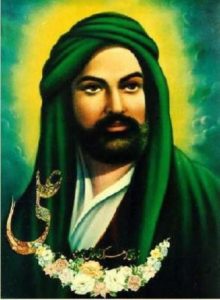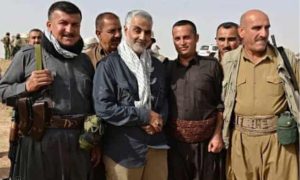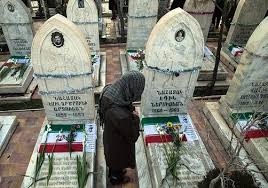FROM WIKIPEDIA AND OTHER SOURCES:
Qasem Soleimani (Persian: قاسم سلیمانی, pronounced [ɢɒːˌsem(e) solejmɒːˈniː]

Life is not simple. The US government claimed that Soleimani was responsible for the recent rocket attack against a Saudi oil facility, killing of U.S. Civilian, shooting down of U.S. aerial vehicles and other acts of war. Is that waht Trump means by terrorism?
The gory image of Iran’s hero comes from three sources .., Sunni Arabs, Israelis, and Americans.
- Sunni arabs today live in chaos. Where there is order, it is opposed by hateful governments sponsored by the Saudi royal family. That family is corrupt and makes claims to Mecca based of a colonial era collaboration with the British that still elicits hate in the Muslim world. Iranian backed shia groups in Yemen, Syria, and Lebanon fought their Sunni neighbors in wars marked by blood nad gore worthy of the history that divides shia and Sunni (see box to right).
- Israel today is the dominant military presence in an overwhelmingly Arab world. After Americas neom conservative led disastrous war on Iraq, only Iran remains as a military enemy to the Jewish state. The Iran backed forces against Israel use asymmetric warfare, that is rightly called terrorism by the Israelis who should, however, remember the ulgly role Jewish terrorism played in founding of the Zionist state.
- America’s role is psychotic. Once we saw Iran as our great ally in the middle east. Then the Iranians overthrew the US appointed Shah and since then we and Iran have lived in hate. To a large part this reflects two American allies. The first is Israel. From its founding, the Iranian Republic has seen the Israelis as a colonial remnant occupying a Muslim land. The second is Saudi Arabia where a hereditary monarchy lives wanton lives that defy Muslim standards.
Iranians, Trump’s claims that the General was the world’s number one terrorist come from Americans with more than enough of our own guilt and near total failure to understand religious and secular divides in the region other tha from a Saudi or Israeli point of view.
The Iranian view is simple and more than a little based on five historic facts.
- WE, the USA, overthrew democracy in Iran
- WE, the USA, sponsored a war on Iran that cost a million Iranian lives.
- WE, the USA, invaded Iraq and failed to establish a viable government so ISIS appeared
- WE, the USA, supported a failed revolution in Syria that cost 100s of thousands of lives.
- WE,, the USA, currently support Saudi bombing and massacres in Yemen and Sudan.
Opposing the US is enough reason for Iranians to see America’s picture of Solemeni as bizarre and hateful. I have tried to find whewre that claim might be justified, but what I can find is a story that looks more like an Iranian hero then an terrorist.
Qassem Soleimani was born to a poor family in the village of Qanat-e Malek. Iran at that time was ruled by the Shah, a CIA appointed ruler reviled by the Iranians. After finishihg primary school , Qassem moved to the city of Kerman and worked on a construction site to help repay his father’s agricultural debts.
When not at work, Qassem spent his time attending the sermons of Hojjat Kamyab, a radical islamist preacher and a protege of Ayatollah Ali Khamenei. Qassem said that the future leader of Iran, spurred him to ‘revolutionary activities’.
Soleimani joined the Revolutionary Guard (IRGC) in 1979 following the Iranian Revolution, which saw the Shah fall and Ayatollah Khomeini take power under a unique form of Islamic democracy with rule by the religous leaders over a popularly elected parliament. While Americans see this as totalitarian, the fact is that Iran and Turley are the only Mideastern states with any form of islamic democracy.
Qassem’s military training was minimal, but he advanced rapidly. Early in his career , he was stationed in northwestern Iran, and participated in the suppression of a Kurdish separatist uprising in West Azerbaijan Province.

To understand Solemeini, you need to realize that Iran’s Persian majority are not Arabs. Hatred between Arabs and Persians dates back to 651 with the Muslim conquest of the Sasanian Empire .. the Persian predecessor of today’s Iran. The Persians were Zoroastrian and the Sunni Arabs, in defiance of the Quran, used their military might to slaughter the Zoarastrians and enforce the religion of the Prophet. To make this worse, a Muslim schism Muslim arose from a bloody conflict within Islam itself. The dispute was over the succession to Muhammad. Shias regard Ali, a cousin of Muhamaud as the first Imam or great teacher. Ali and his descendants are tthe only legitimate religious and political leaders of the Muslim community. Ali is infallible and sinless and is one of The Fourteen Infallibles of the household of Muhammed. The dispute came to a head after the Battle of Karbala, in which Hussein ibn Ali and his household were killed by the ruling Sunni Caliph Yazid I, The outcry for revenge divided the early Islamic community. Today’s Shia, called “twelvers,” beleive that the Mahdi will be Muhammad al-Mahdi, the twelfth Imam returned from the Occultation, where he has been hidden by Allah since 874. In contrast, mainstream Sunnis believe the Mahdi will be named Muhammad, be a descendant of Muhammad, and will revive the faith, but will not necessarily be connected with the end of the world.
Qassem’s great fame began as an officer in the Iraq-Iran war. This was a brutal fight with a million lost on each side.
QUOTES:
I entered the [Iran-Iraq war] on a fifteen-day mission, and ended up staying until the end … We were all young and wanted to serve the revolution.
One type of paradise that is portrayed for mankind is streams, beautiful nymphs and greeneries. But there is another kind of paradise. … The warfront was the lost paradise of the human beings, indeed.
When I see the children of the martyrs, I want to smell their scent, and I lose myself.
We’re not like the Americans. We don’t abandon our friends
During Sadaam Hussein’s US sponsored war, 1 million Iraquis died, some from Iraqui poison gas attacks. Soleimani joined the battlefield assembling a cadre and as the leading a military company from his home town. Participating in most major operations the company was mostly stationed at the southern front. Still in his twenties, the young officer retook lands Iraq had occupied, eventually becoming the commander of the 41st Tharallah Division while still in his 20s. He was also engaged in leading and organizing irregular warfare missions deep inside Iraq carried out by the Ramadan Headquarters. The future General was seriously injured in Operation Tariq-ol-Qods.
As Division commander , Soleimani established relations with Kurdish Iraqi leaders and the Shia Badr Organization, both of which were opposed to Iraq’s Saddam Hussein.
After the war, during the 1990s, Soleimeni was a Revolutionary Guard commander in his home province. Close to Afghanistan, Soleimani’s military experience helped him earn a reputation as a fighter against drug trafficking in Afghan-grown opium on its way to Turkey and Europe.

Solemeini in Iraqui Kurdiatgan with Kurdish fighters during the war on Isis. The Iranian general led that war, bringing together Shia militias and Kurdish forces to win a war the US could not win.
Sometime between 1997 and 1998 Soleimeni was considered one of the possible successors to the post of commander of the Revolutionary Guards. Following the 9-11 attacks on the US in 2001, Ryan Crocker (later US ambassador to Iraq) flew to Geneva to meet with Iranian diplomats under the direction of Soleimani with the purpose of collaborating to destroy the Taliban. This collaboration was instrumental in defining the targets of bombing operations in Afghanistan and in capturing key Al-Qaeda operatives.
That collaboration ended abruptly ended in January 2002, when President George W.  Bush named Iran as part of the “Axis of Evil.” The susbequent Iraqui war led to a disastrous increase in extremist el Qaeda activities in Iraq and, ultimately to the formation of ISIS.
Bush named Iran as part of the “Axis of Evil.” The susbequent Iraqui war led to a disastrous increase in extremist el Qaeda activities in Iraq and, ultimately to the formation of ISIS.
At this point the story about Shia vs Sunni becomes key. In its simplest form, there is a 1500 year history of hatred between Sunni Arabs and Iranian Shiites. When Bush invaded Iraq, the US overthrow a dictator who imposed Sunni Arab rule over a state comprised of Shia Arabs, Sunni Arabs and Sunni Kurds. Sadaam Hussein was a Sunni but most of Iraq’s oil wealth was in in Shiite or Kurdish regions.
The Sunni, deprived of rule under Sadaam, moreover, were fertile ground for revolution leading to the formation of ISIS.
]In 2008, Soleimani helped arrange a ceasefire between the Iraqi Army and Mahdi Army in March 2008. Later, under Obama, the US collaborated with Solemeni led Iraqui forces in the ultimate defeat of ISIS in Iraq and Syria.
During all this Solemeini was responsible for developing an asymmetric strategy to spread Iranian Shia influence in the Arab states. In 2011, Soleimani was promoted to Major General by Supreme Leader Ali Khamenei. As the commander of the Quds force, Solemeini played a key in the organization of the Iraqi government, notably supporting the election of previous Iraqi Prime Minister Nuri Al-Maliki the first Shia head of the Iraqi state.
Soleimani also payed a major role in the war in Syria. After Saudi and US sponsored insurgencies failed to overthrow Bashar Al Assad. The Syrian dictator belongs to a Shia sect and the Iranian helped bolster the Bashar al-Assad government. Ultimately, with the US and its Saudimallies defeated in Syria, it was Solemeini who helped to plan Russian military intervention in Syria. Soleimani also was commander of the combined Iraqi government, Syrian and Shia militia forces that advanced against ISIL in 2014–2015. Soleimani was one of the first to support Kurdish forces, providing them with arms.
Ayatollah Khamenei, Iran’s supreme leader, described Soleimani as a “living martyr” and at least one CIA agent identified the Iranian as “the single most powerful operative in the Middle East today” and the principal military strategist and tactician in Iran’s effort to combat Western influence and promote the expansion of Shiite and Iranian influence throughout the Middle East.
I agree with much of your analysis in regards to the bloodlust that currently captures politics, and also when it comes to the horrific US actions towards Iraq and Iran (including the coup and the Iraq-Iran war), but it also seemed that Solemeini had a lot of blood on his hands. Most of the deaths in Syria, for example, were attributable to the Syrian-Iranian coalition and the insurgency in Iraq was often described as indiscriminate in its targeting of civilian populations. I would say two times wrong does not make right.
I expect you are correct and that probably explains my friend’s hate for him. Not to defend Solemeini but it is also true that the Sunni rebels in Syria were indescribable. The line from ISIS to Saudi/Israeli/American surrogates was never clear. With no admirable revolutionary cadre and Assad’s long history of terror against his own people, wasn’t what you describe inevitable when Iran tried to intervene?
This reminds me of the Sabra and Shatila massacres in Lebanon. From what I have read these were the work of Christian militias who could do their dirty acts because of the Israeli invasion. Was Ariel Sharon a demon because of what he enabled?